Ah, autumn has arrived.
The air has suddenly become dry, and my throat has taken a hit, giving my voice a deeper tone instead.
It’s me, Comuni.
This time, I’d like to share the highlights from the 8th NARA Wine Gathering.
Recently, the NARA Wine Gatherings have alternated between “European Bar En” and “Brasserie L’Oiseau Bleu.”
For this gathering, the venue was none other than Brasserie L’Oiseau Bleu.
I’ve also introduced this establishment in a previous article, so please take a look at that as well.
Now, this time’s theme is Jura!!
Vin Jaune and Vin de Paille are famous examples, aren’t they?
For exam preparation, some of you might have memorized it alongside Savoie, under “Jura-Savoie.”
Even in the 2020 edition of the reference book that I own, it’s structured as a chapter on the “Jura-Savoie region.”
What kinds of wines and pairings with delightful dishes await us this time?
Let’s dive right in!
Check it out.
What is Jura?
A sudden question for everyone who’s not a certified sommelier or preparing for a wine qualification exam—how many of you know exactly where the Jura region is located in France?
If you know, you’re truly brilliant.
If you don’t, please don’t feel disheartened. Today, let’s at least take away a general sense of its location (although that’s not the main purpose here).
The Jura region is situated in eastern France, on the western side of the Jura Mountains.
Hmm, sounds clear but not quite, right?
Actually, from Arbois—the central town of Jura—to the west, across the Saône River, lies Beaune, the renowned heart of Burgundy.
It’s quite startling to see such a major wine-producing area suddenly pop up, isn’t it?
To say it simply again: East of the Saône River is Beaune, and to the west is Jura.
Starting to make sense now?
Have you heard of Cote-d`Or?
It’s incredibly famous for producing extraordinary wines, practically sparkling like stars.
Often translated as “Golden Hills,” the name actually derives from ORIENTAL—meaning east-facing slopes. Who would’ve thought it comes from the perspective of the Saône River? (Or maybe not!)
Perhaps this geographical connection explains why Jura often uses grape varieties like Chardonnay and Pinot, which are common in Beaune, sharing a similar character.
However, the definitive difference lies in the amount of rainfall. Being inland, Jura experiences a continental climate and is ranked as the third-rainiest region in France.
Another notable aspect is the high proportion of organic farming. Despite an annual rainfall of 1150mm, more than 20% of vineyards practice organic cultivation, with many natural wines produced too.
It’s easy to imagine how challenging such management must be. Jura’s passion truly knows no bounds.
Speaking of Arbois, it’s also famous as the birthplace of Louis Pasteur, often called the father of microbiology.
His contributions to the understanding of alcohol fermentation mechanisms and the invention of pasteurization marked significant advancements in brewing and left an incredible legacy.
Thank you, Mr. Louis.
Starting to get a feel for Jura now, right?
The “5 Grape Varieties” of Jura
You might be thinking, “Just talk about the wines and food you’ve had already!”
Calm down.
I fully admit that I’m borrowing from Mr. Eiji here, but please allow me this chance to share my insights.
So, let’s reflect using the summary Mr. Eiji created in a burst of late-night inspiration.
① Savagnin
When it comes to Jura, the strong association with Savagnin, used for Vin Jaune, might come to mind.
However, across the whole Jura region, it only accounts for about 20%.
The exact origins of this grape variety remain unclear, but DNA analysis reveals that Savagnin is an ancestor to many grape varieties—a true “Big Daddy” of the grape world.
It’s believed to have arrived from Austria or Hungary during the Crusades.
With its thick skin and resistance to diseases, along with early budding, it’s well-suited for Jura, where frost is common.
It’s known for producing wines with high acidity and refreshing apple or lemon flavors. This high acidity makes it ideal for aging.
So let’s not underestimate Savagnin, shall we?
② Chardonnay
An undeniable major grape variety.
While Savagnin might be the image of Jura, Chardonnay actually dominates, covering 40% of the region’s vineyard area.
Chardonnay is impressive as always!
In fact, it has been cultivated in Jura since the 10th century.
In Japan, that would correspond to the Heian period—a time when court culture flourished, and elegant poetry was composed.
③ Poulsard
This one also originates from Jura.
Like Savagnin, it buds early and ripens relatively quickly.
While its clusters are small, the berries are large with thin skin.
It seems it would make juicy wines, though I can’t help but worry if they might burst due to Jura’s high rainfall.
Thanks to its thin skin, it produces pale-colored wines—delicate yet elegant, creating light and refined reds.
④ Trousseau
This variety is also native to Jura and is, in fact, a child of the “Big Daddy” Savagnin.
It ripens early, has thick skin, and produces wines with more strength compared to Poulsard.
Its potential for aging is a trait it inherits from Savagnin.
Although it originates in Jura, Trousseau is widely cultivated in Portugal, where it’s known as Bastardo and used in the production of Port wine.
One can imagine how proud “Big Daddy” Savagnin must be of its offspring’s international achievements (or so we assume).
⑤ Pinot Noir
Another undeniably major grape variety.
Perhaps due to its proximity to Beaune, Pinot Noir accounts for about 10% of Jura’s vineyard area.
Pinot Noir arrived in Jura around the 15th century.
It was a time of Renaissance and Joan of Arc in Europe—while in Japan, there were the Ming Dynasty trade and the Ōnin War. It was the beginning of the Sengoku period. (But I digress.)
Apologies in advance if any details are incorrect!
Cheers!
Now, let’s move on to the food and wine introduction.
First pour: Crémant
We began with this delightful Crémant:
Domaine Baud Génération 9 Crémant du Jura Brut NV
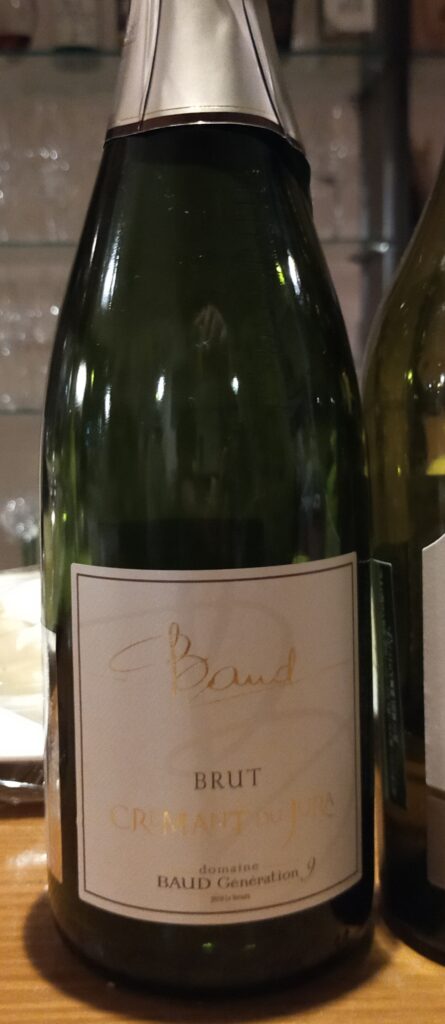
Domaine Baud is a venerable winery, established in 1740, and is currently run by Bastien, the ninth-generation successor. The name “Generation 9” reflects this legacy.
This Crémant is crafted from 100% Chardonnay.
According to Mr. Eiji, it has a warm, soft impression rather than a crisp, sharp feel. He even described it as autumn-like and hearty, which aligns with the overall essence of Jura that I’ve come to perceive.
It’s not the kind of bubbly that you crave for its fresh, zippy malic acid during summer; instead, it offers a gentle, mellow taste—perfectly soothing.
That day, we raised a toast to celebrate the completion of the second exams for sommeliers, wine experts, and sake diploma candidates.
Since bubbly wine isn’t included in the exam questions, some attendees may not have had it for quite a while. This gentle sparkling wine must have felt like a soothing balm for their tired bodies and minds.
Dish pairing: Avocado mousse & smoked salmon
The dish featured a small choux pastry, peeking through with avocado mousse and smoked salmon.
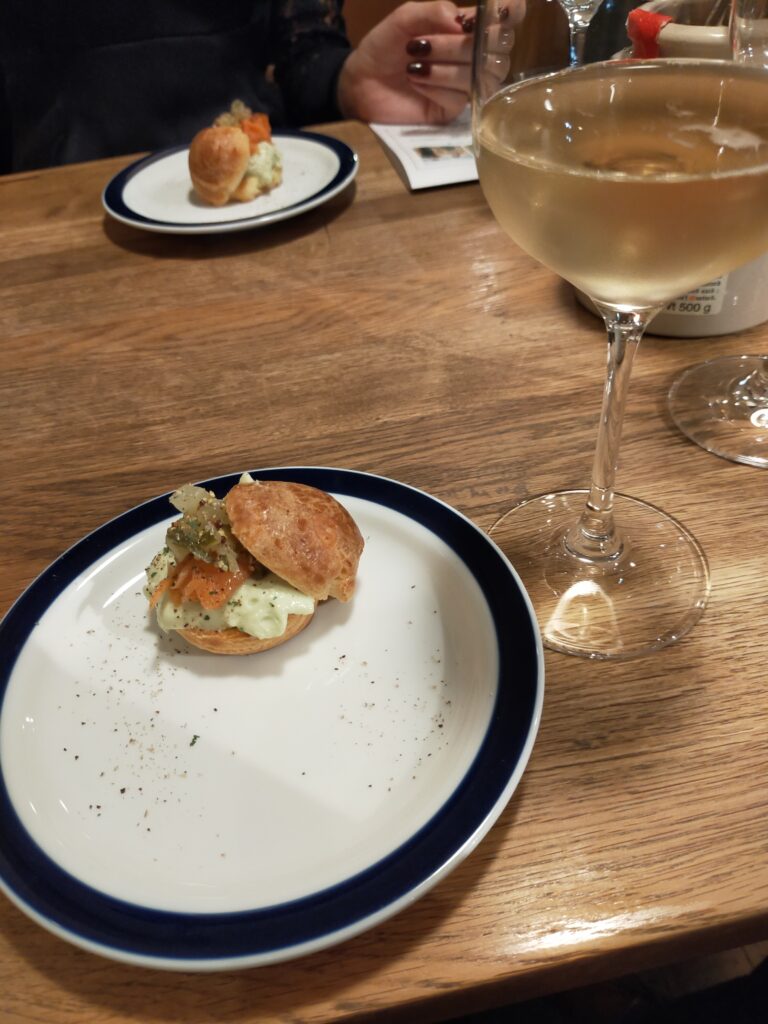
While I wished I could grab it like a hamburger and devour it with one hand, I was surrounded by elegant ladies, so I behaved and used a knife and fork.
The combination of the aromatic choux pastry, silky avocado, and the saltiness and complexity of the smoked salmon was delightful.
To enhance it further, a small dollop of mustard-flavored cornichon pickle on top provided an accent that tied everything together.
As I munched on the dish while enjoying the bubbly wine, I felt transported to Arbois. (Though I’ve never been there.)
Hello, Mr. Pasteur—what an experience!
This was such a splendid start to the evening.
The Second Wine: Another Domaine Baud Creation
Next up, we enjoyed yet another wine from Domaine Baud:
Domaine Baud Génération 9 l’Etoile 2019

L’Étoile is the name of this AOC.
By the way, “L’Étoile” means “star” in French. According to the textbook, the name originates from the five hills surrounding the village of L’Étoile, forming a star-like pattern. Additionally, the soil in this area contains star-shaped fossils—likely fossilized starfish. Fascinating, isn’t it?
This wine is made from 100% hand-harvested Chardonnay.
Like the Crémant we tried earlier, this one also has a soft, warm impression.
It has a slightly sherry-like aroma with clean acidity—a fragrance that feels quintessentially Jura.
Although it’s made with a natural approach, the wine is exceptionally clean. The liquid sparkles, brimming with energy.
I love it.
The Pairings
The menu initially listed a salad with prosciutto, but the cheese course was served first.
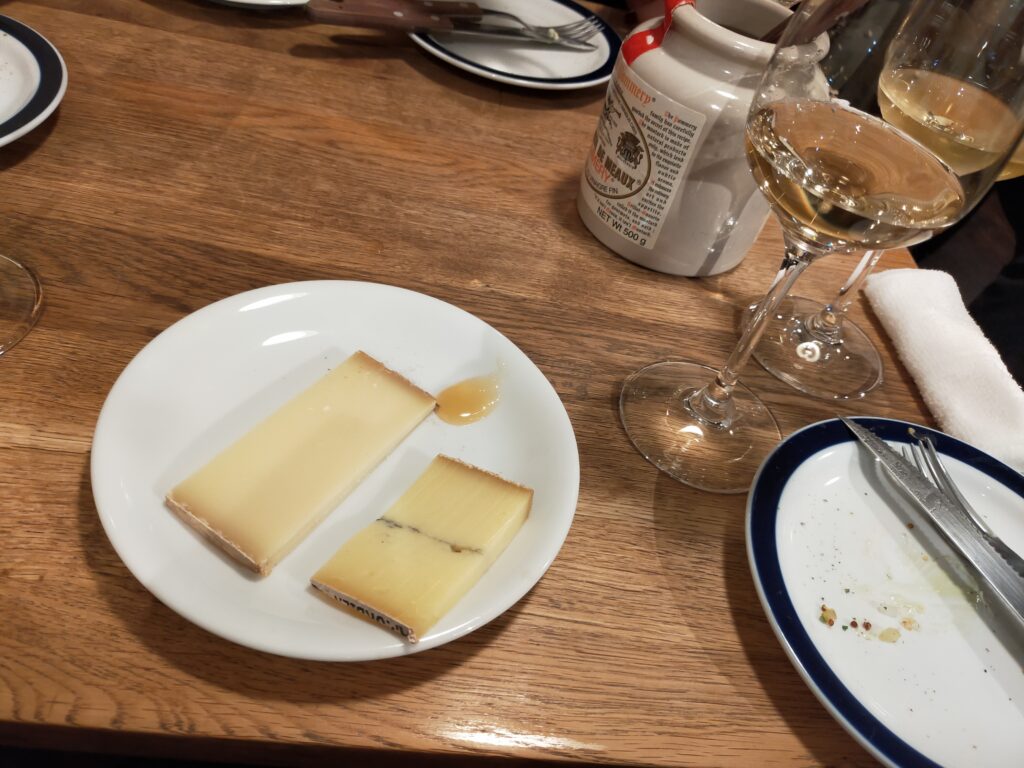
The cheese selection for the evening featured 12-month-aged Comté and Morbier (apologies, I don’t recall Morbier’s aging period).
These two cheeses were introduced during an online cheese and wine gathering led by Mashumao-san—an elegant sommelier, manager, and cheese professional. If you’re interested, check out the following article:
The staff kindly advised us, “Since the aged rind is tough, please remove it.”
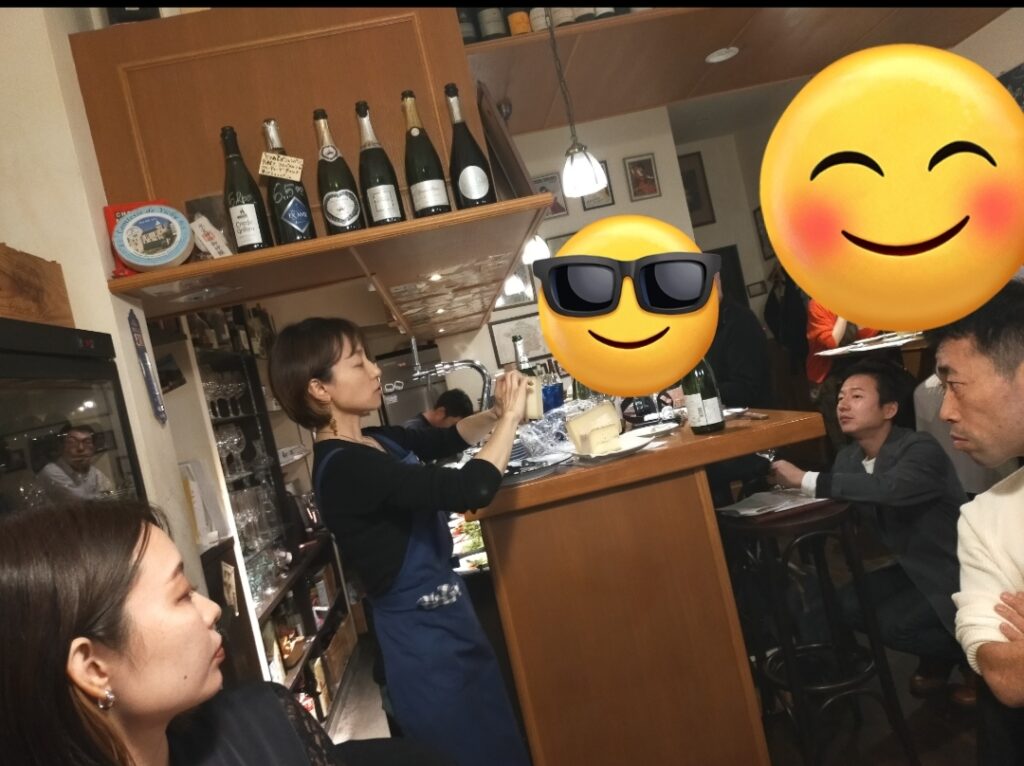
However, being an impatient person, I started eating before listening to the explanation. Naturally, I ended up eating the tough rind as well.
Lesson learned: Always listen to instructions till the end! (Note to self.)
Soon after, freshly baked bread arrived. Its aroma was irresistible, and I couldn’t stop myself from indulging.
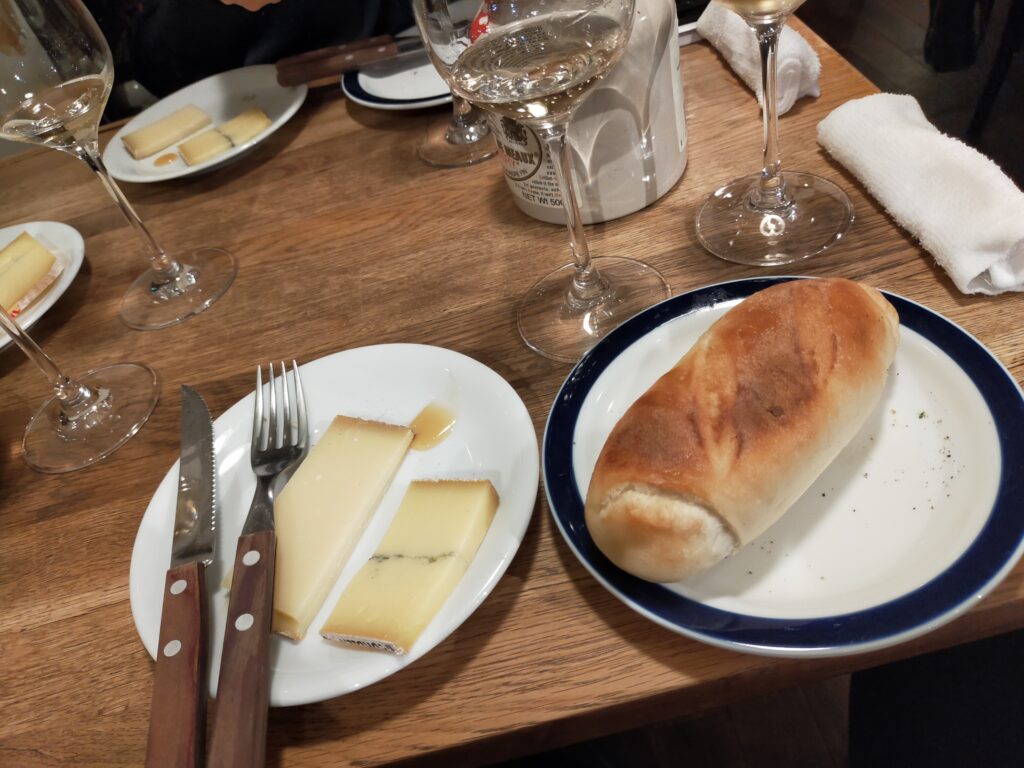
The wine paired beautifully with everything. Simply put—bliss.
The Salad
Then came the salad: Rösti with Prosciutto Salad.
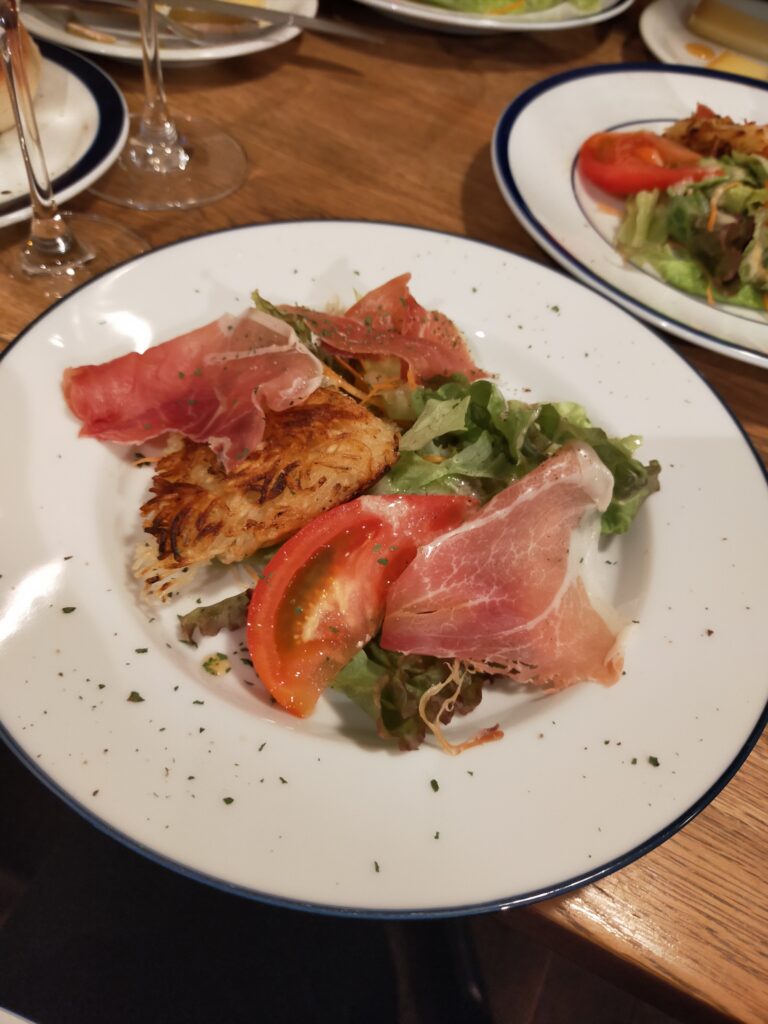
Rösti, I learned, is a Swiss dish made from potatoes. Originally, the term referred to any roasted dish cooked on a grill, but now it’s exclusively used for potato-based recipes.
It’s somewhat similar to a potato galette. You can just tell it’s going to be delicious!
The dressing and tomatoes added just the right amount of acidity, while the roasted potatoes brought their nutty, hearty flavor. The prosciutto added a savory, matured saltiness, and the greens provided a fresh herbal note.
Combined with the wine, it created a vivid, layered symphony of textures and flavors in my mouth.
“Mm-hmm~” (translation: “delicious”) became my mantra for the moment.
The Third Glass: Savagnin Tasting
For the third and fourth glasses, we had a comparative tasting of Savagnin.
Let’s start with this one:
Les 5wy PRÉMICES Savagnin Ouillé 2018
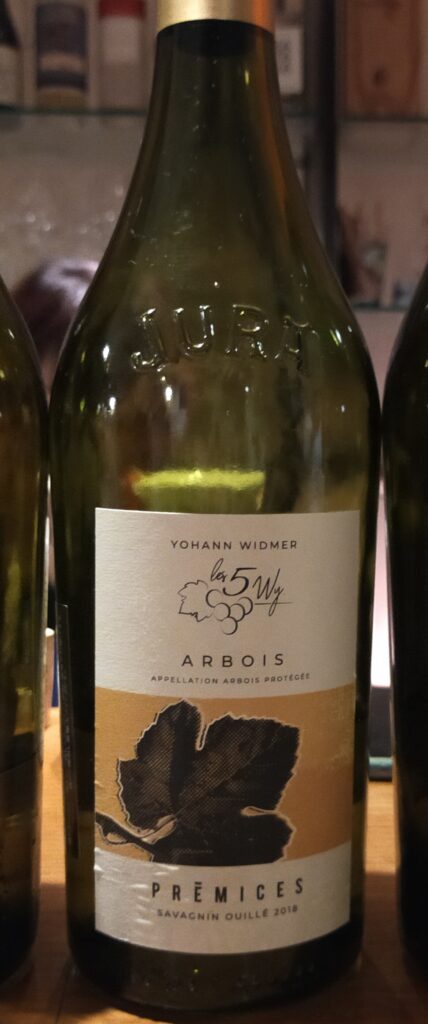
“PRÉMICES” means “first fruits,” emphasizing that this Savagnin is aged with ouillage (topping up) rather than oxidative aging.
During barrel aging, evaporation reduces the liquid volume, creating headspace. If left unfilled, the wine oxidizes more than desired. Ouillage prevents this by topping up the barrel with the same wine to eliminate headspace and avoid excess oxidation.
In this region, it’s famous to intentionally skip ouillage, allowing flor yeast to form for oxidative aging. However, this wine opts for the opposite approach—a deliberate, unconventional move.
It feels like coming full circle—welcome back to the basics.
Whatever the method, this wine is clearly crafted with meticulous attention rather than chance.
The Dish: Buckwheat Gnocchi with Pork and Beans
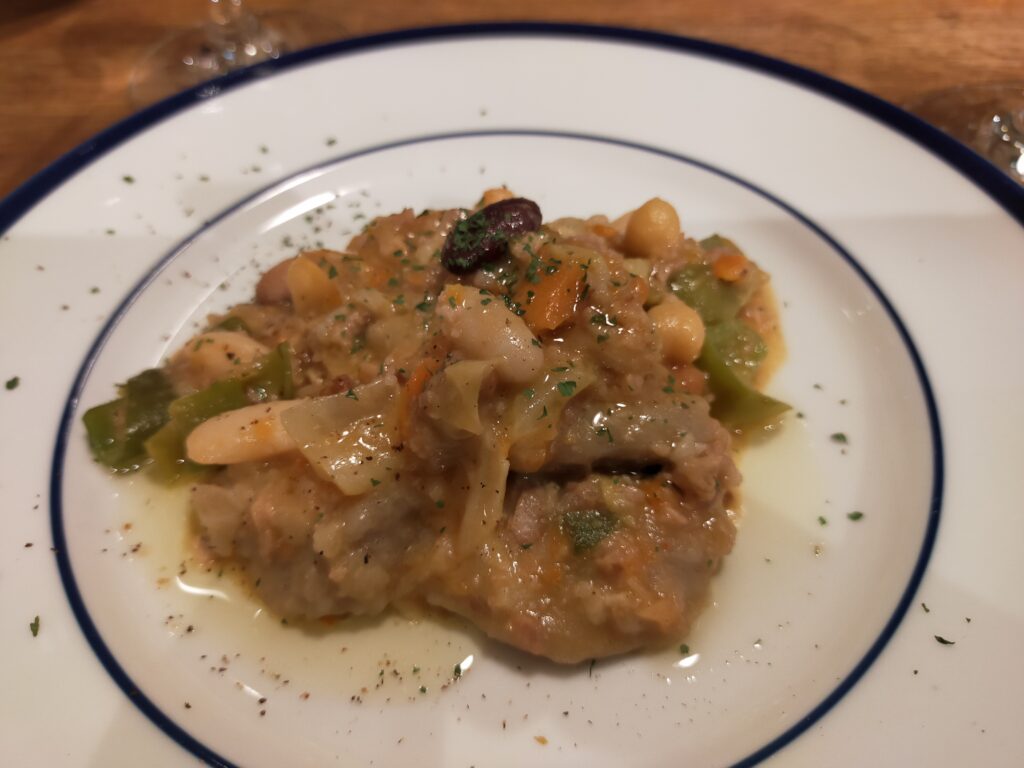
As we savored the wine, the food arrived:
Pork and Various Beans with Buckwheat Gnocchi
The gnocchi, made from buckwheat flour, is served in a rich, savory bean sauce infused with the essence of pork.
Essentially, it’s a take on Pasta e Fagioli.
The aroma of buckwheat complements the hearty texture of the beans.
Paired with the wine, whose acidity brings clarity, even a rich dish like this feels lighter and more refreshing.
Interestingly, the sweetness of the wine seemed more pronounced when enjoyed alongside the dish than when tasted alone.
The Fourth Glass
Domaine de la Renardiére Les Terrasses Arbois Pupillin 2017
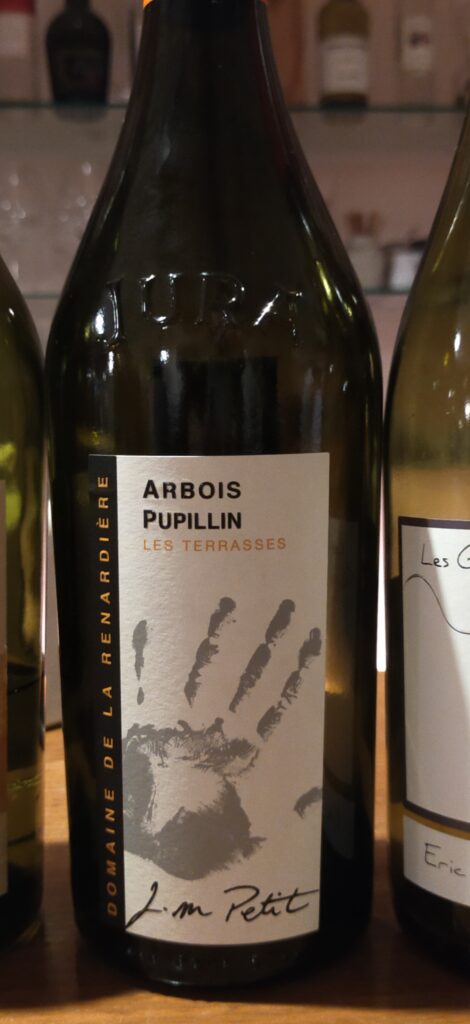
This wine, like the previous one, is made from 100% Savagnin with ouillage (topping up) to prevent oxidation during aging.
Both the third and fourth glasses featured a style where oxygen exposure is minimized, allowing the pure flavors of Savagnin to shine through.
This wine had fresh aromas complemented by gentle barrel nuances.
Perhaps this one had a slightly deeper color compared to the previous wine.
Tasting Reflections
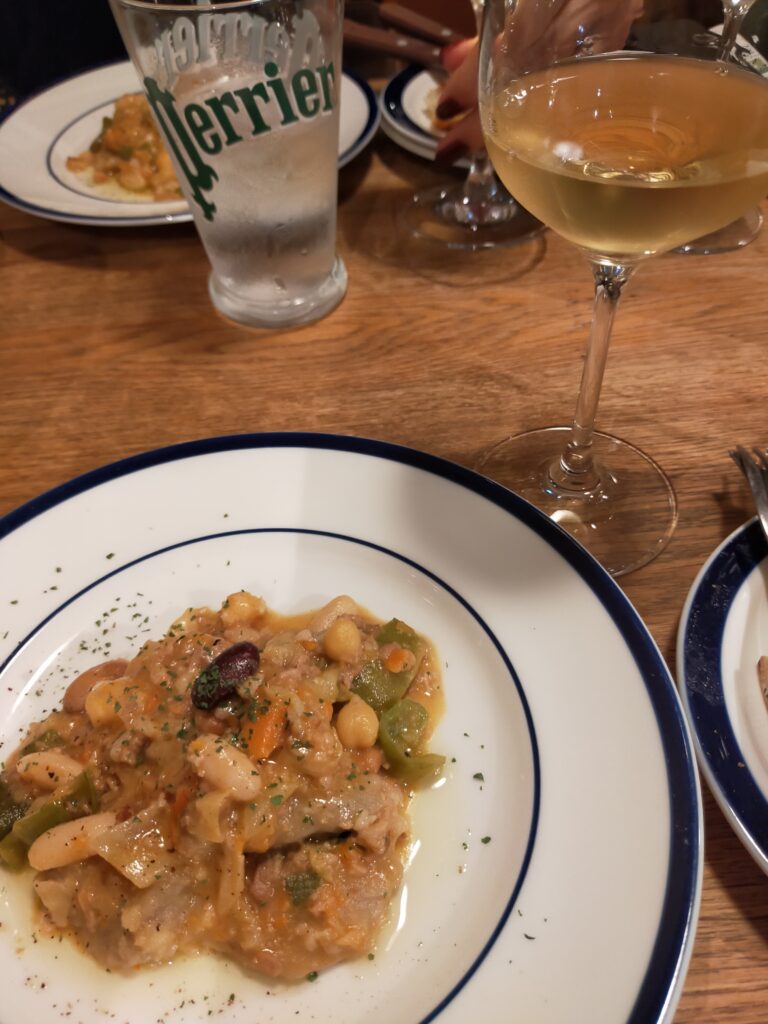
This was my first experience comparing Savagnin wines side by side.
I was pleasantly surprised by the clean impression of acidity combined with a warm, inviting atmosphere.
I’ve truly fallen in love with Savagnin.
The Fifth Glass: Today’s Sole Red
The fifth glass featured the only red wine of the evening:
Eric et Bérengère Thill Poulsard Les Grandes Vignes 2018
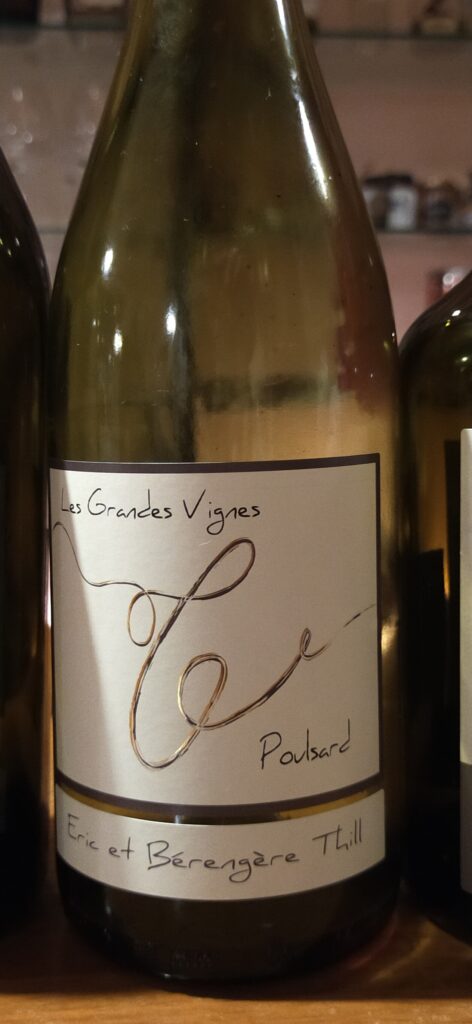
This delightful wine is made from Poulsard, a native grape variety of Jura.
The vines used for this wine have an average age of 50 years—a true Vieilles Vignes.
Its production is entirely natural, with no pigeage (punching down) or remontage (pumping over) techniques involved.
The serving temperature seemed slightly on the cooler side, so I initially intended to wait for it to warm up a bit.
But my impatience got the better of me, and I ended up cradling the glass in my hands to warm it slightly before taking a sip.
The wine certainly had a light and lively feel to it, yet I couldn’t help but sense some similarities to Pinot Noir.
If my observation is off, please forgive me!
The relaxed atmosphere of the evening likely influenced my tasting notes, and admittedly, the photos I took don’t do the wine justice.
I hope the delicate nature of this wine comes through.
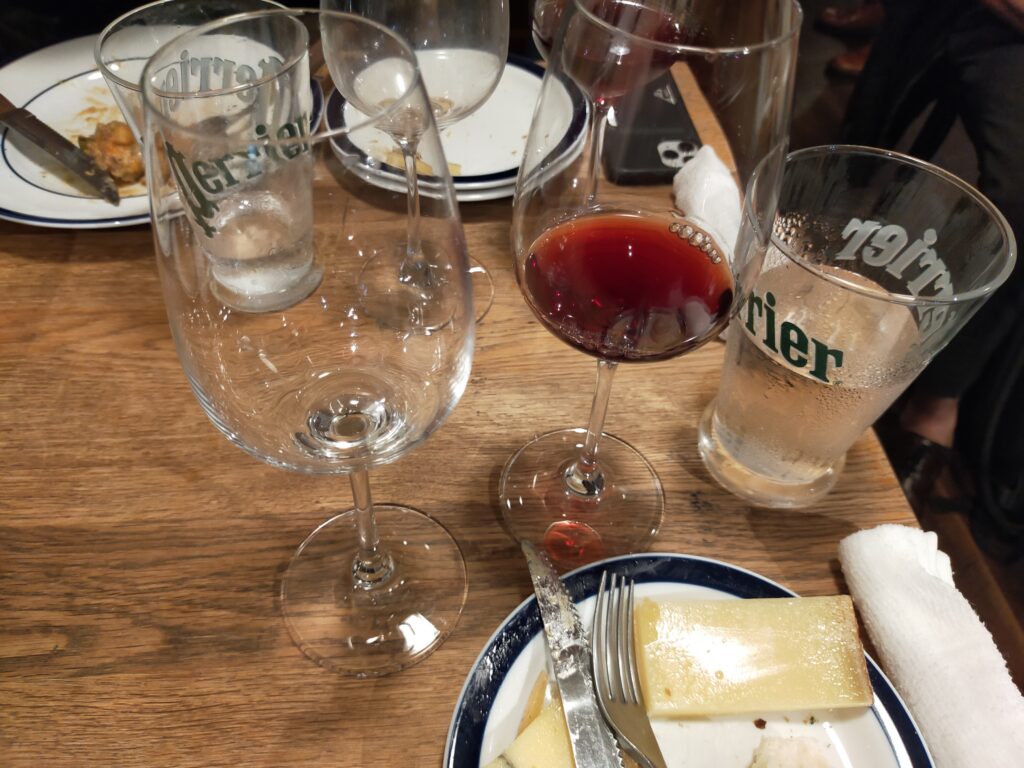
This wine perfectly suited my preferences—a truly enjoyable experience.
The Sixth Glass: Vin Jaune
At last, Vin Jaune makes its grand debut.
It’s a bit embarrassing to admit, but this is my first encounter with Vin Jaune.
Domaine Baud Génération 9 Vin Jaune 2015
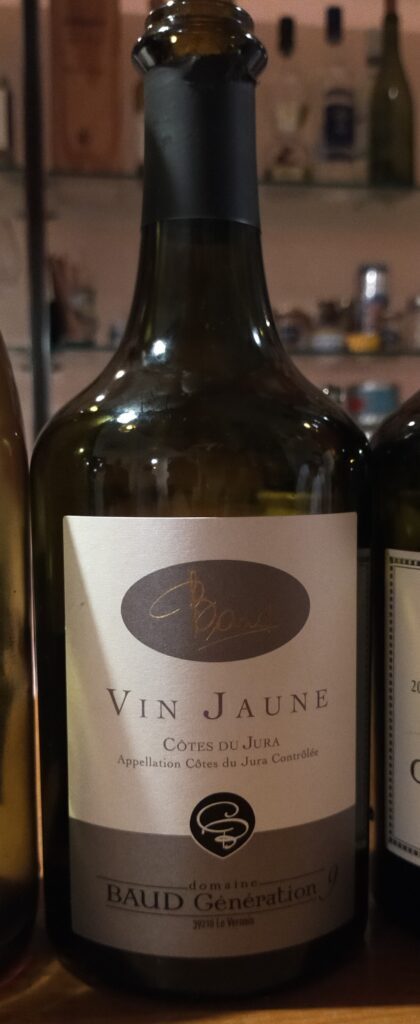
This wine is made from 100% Savagnin and aged for seven years.
It has a distinctive sherry-like aroma along with a rich, nutty fragrance.
If I remember correctly, aging under flor yeast (the protective surface layer) contributes caramel and nutty notes derived from sotolon. Additionally, acetaldehyde imparts aromas of apple peel and ginger.
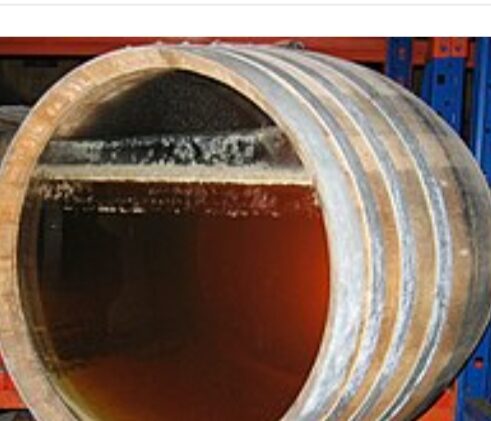
Unlike ouillage (topping up), Vin Jaune is intentionally exposed to air during aging.
Through maturation under flor yeast, acetaldehyde protects the wine from excessive oxidation while simultaneously introducing unique aromas.
It’s a curious paradox—deliberately oxidized yet safeguarded—a truly fascinating wine.
Moreover, acetaldehyde consumes glycerin, resulting in a dry finish.
Truly remarkable—a testament to the ingenuity of Jura, home to the legendary Louis Pasteur.
The Dish: Free-range Chicken with Morel Mushrooms à la Vin Jaune
The dish paired with Vin Jaune was an elegant masterpiece:
Free-range chicken with morel mushrooms in a Vin Jaune sauce.
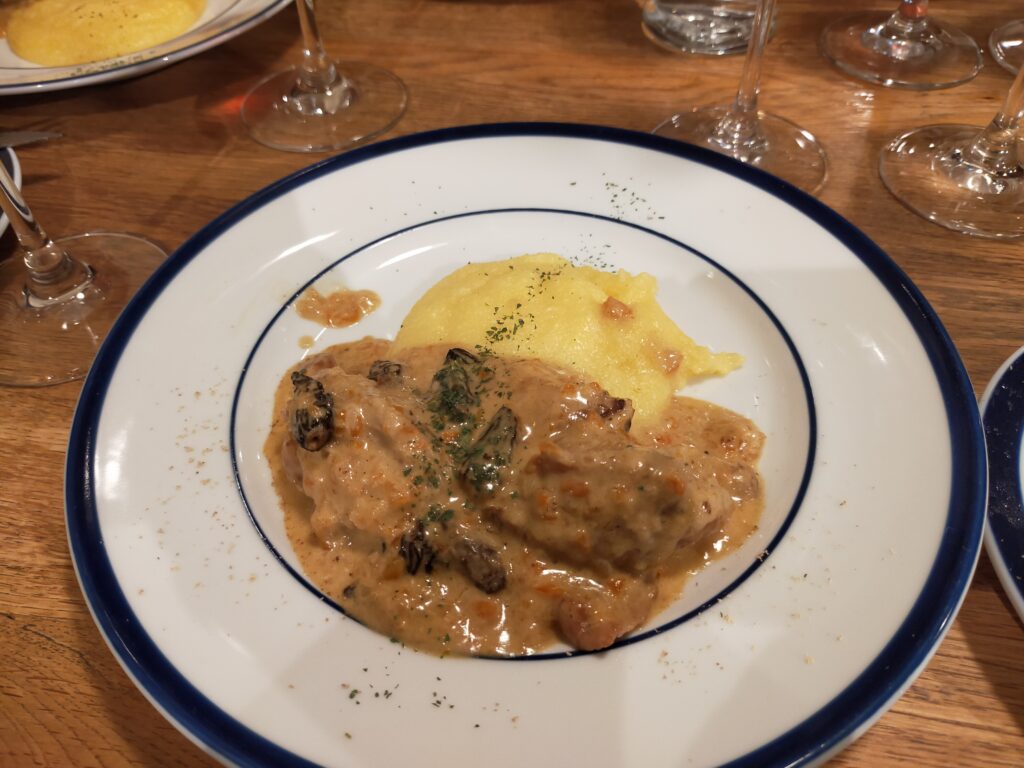
Vin Jaune was subtly incorporated into the sauce—an advanced culinary technique, indeed.
The tender chicken, infused with Vin Jaune’s aroma and the umami of morel mushrooms, was enveloped in a generous, flavorful sauce.
The sauce clung to each fiber of the chicken, creating a truly divine combination.
Delicious beyond words.
Naturally, it paired beautifully with the wine.
The yellow side dish may look like an omelet at first glance, but it’s polenta—made from cornmeal.
It’s been quite a while since I last enjoyed polenta, so this addition made me unexpectedly delighted.
The Seventh Glass
The seventh glass served was:
Domaine Berthet Bondet Chateau Chalon 2013
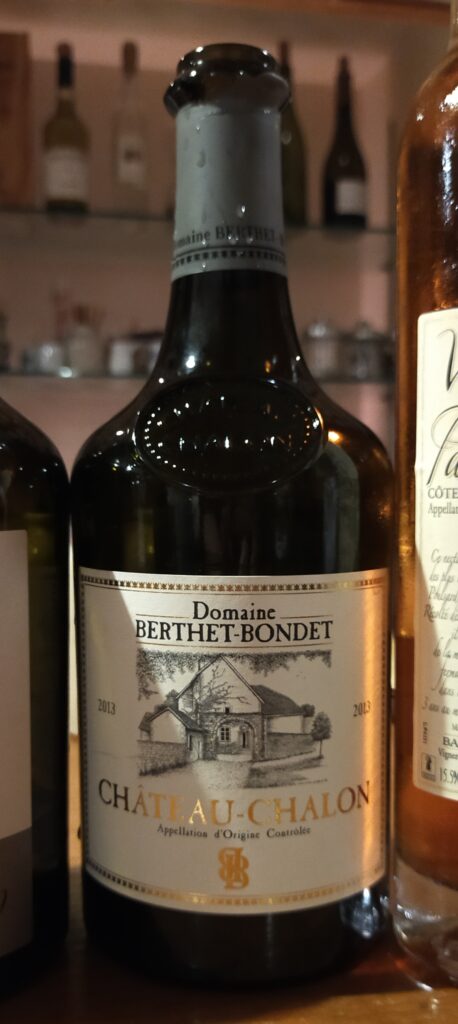
Ah, Chateau Chalon makes an appearance!
In Bordeaux, “Château” is often associated with wine producers who own vineyards and handle the entire process—from cultivation to fermentation, aging, and bottling.
However, this Chateau Chalon refers to the name of the village.
The wine is housed in a shorter, stubbier container called Clavelin, with a capacity of just 620ml—a smaller quantity.
It’s as if the angels took too much of their share during the aging process, and this is the compromise we’re left with. (Just joking!)
I still recall Mr. Eiji humorously saying, “Two tablespoons each. Two tablespoons each,” as he carefully poured the wine.
Indeed, if served at the usual pace, there wouldn’t have been enough for everyone. This required careful attention.
This was also my first time trying Chateau Chalon, and once again, it paired beautifully with the dish.
The acidity of the Savagnin remained prominent, cutting through the creamy richness of the sauce, while the nutty and sherry-like complex aromas lingered after each sip.
It was yet another reminder of how essential acidity is in wine.
And to acetaldehyde—I apologize for assuming you were always the bad guy!
The Eighth Glass
By this point, my stomach was nearing its limit, practically bursting.
However, after learning about the special cheeses during the earlier explanation, I couldn’t resist trying them.
After all, every cheese served thus far had been absolutely delicious.
So, here we have:
24-month-aged Comté and Mont d’Or.
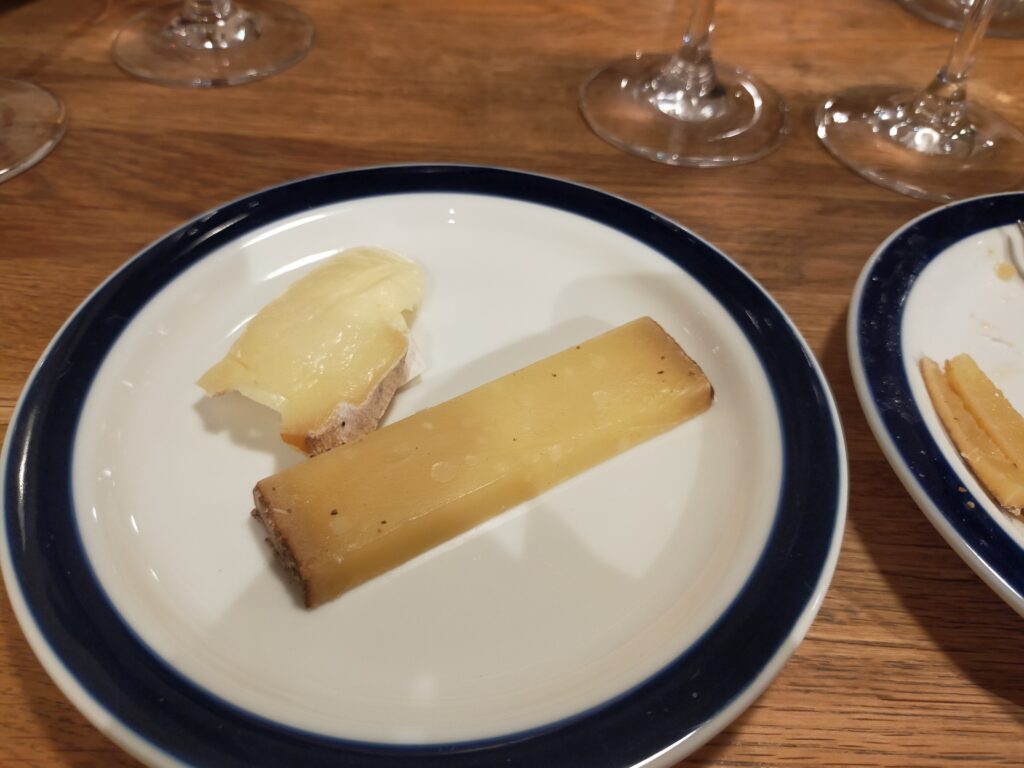
Once again, I was reminded how pairing local cheese and wine from the same region is undeniably wonderful.
The 24-month-aged Comté was exquisite.
Having been Chambred (brought to room temperature), its texture was smooth, and its aroma wonderfully pronounced.
The crystallized amino acids provided an irresistible crunchy sensation.
The Mont d’Or was delightfully creamy—an indulgence beyond words.
Dessert
And finally, dessert made its appearance:
A Basque-style cheesecake, affectionately known as “Baschee.”
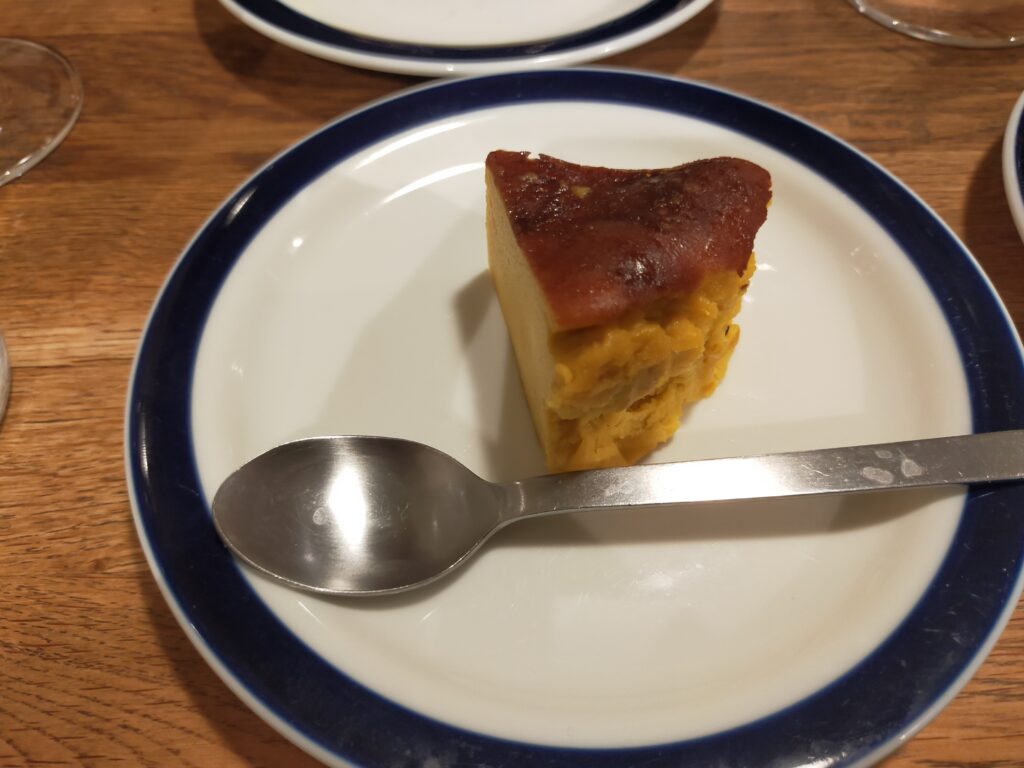
This version featured pumpkin mixed into the recipe.
The rich texture of the Baschee and the hearty warmth of the pumpkin complemented each other beautifully.
In my mind, the Halloween dance number from “Poupelle of Chimney Town” was playing on repeat (though I don’t recall the song’s name).
Dessert Wine Pairing
The wine served with dessert was:
Domaine Baud Génération 9 Vin de Paille 2012
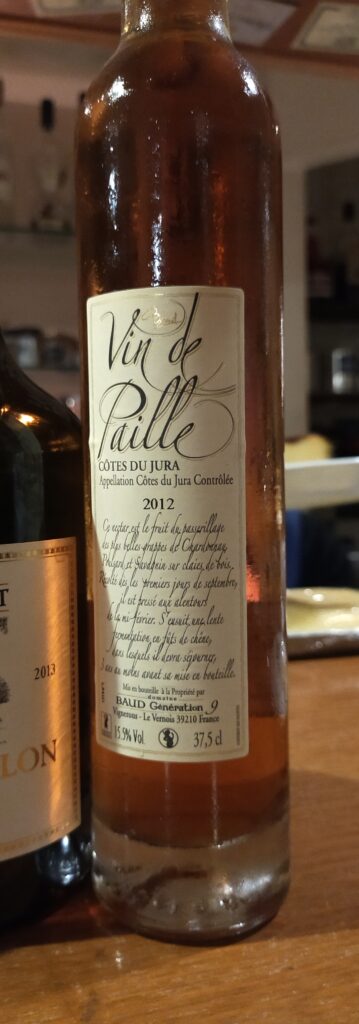
When serving this wine, it was playfully introduced with the words, “Although straw wine doesn’t mean it’s funny wine…”
This sweet wine is made from grapes dried in the shade.
The name Vin de Paille originates from the traditional practice of drying grapes on straw mats before winemaking.
Currently, regulations require the grapes to be dried on straw or racks, or even suspended in well-ventilated areas for a minimum of six weeks.
The result is a concentrated raisin-like aroma paired with a luscious, viscous texture.
Despite its richness, it doesn’t feel overly heavy—thanks to the wine’s balanced acidity.
It was a perfect match for the creamy, dense texture of the Baschee.
Pure bliss.
Dessert wines truly reign supreme, don’t they?
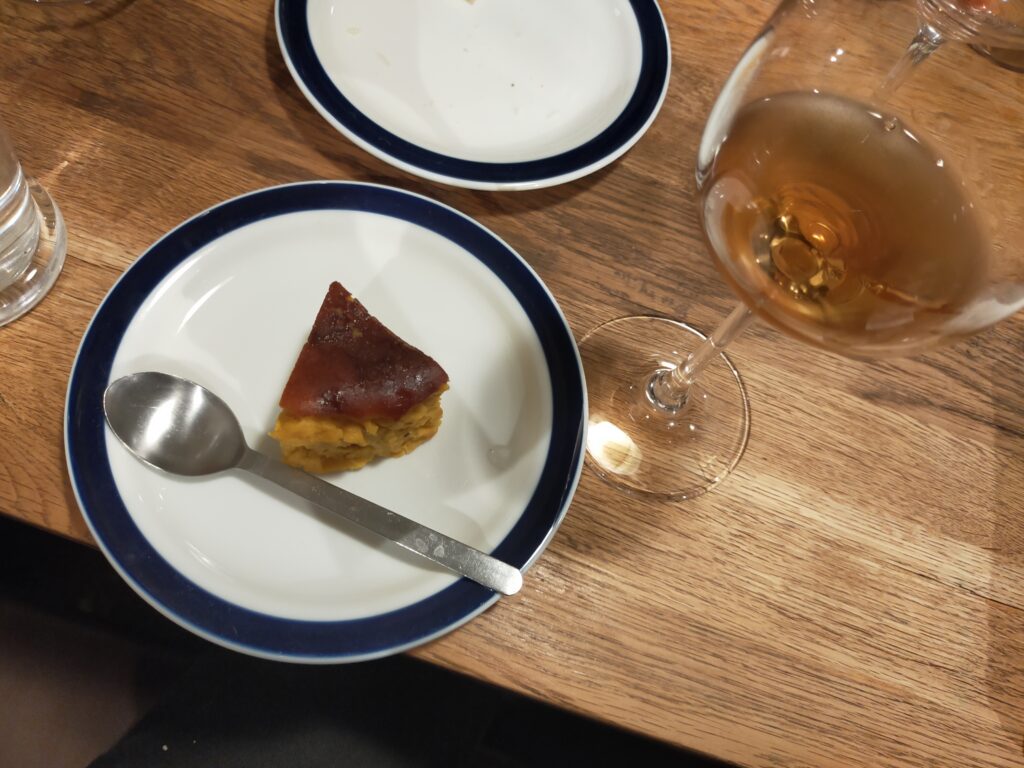
Bonus Round
According to the menu and program, this was supposed to be the end—but the NARA Wine Gathering often surprises us (albeit unpredictably).
This time, Mr. Eiji brought out a wine from Spain that had caught his interest, and we all shared a small taste of it:
Bodegas Jiménez-Landi Vino Naranja 2020
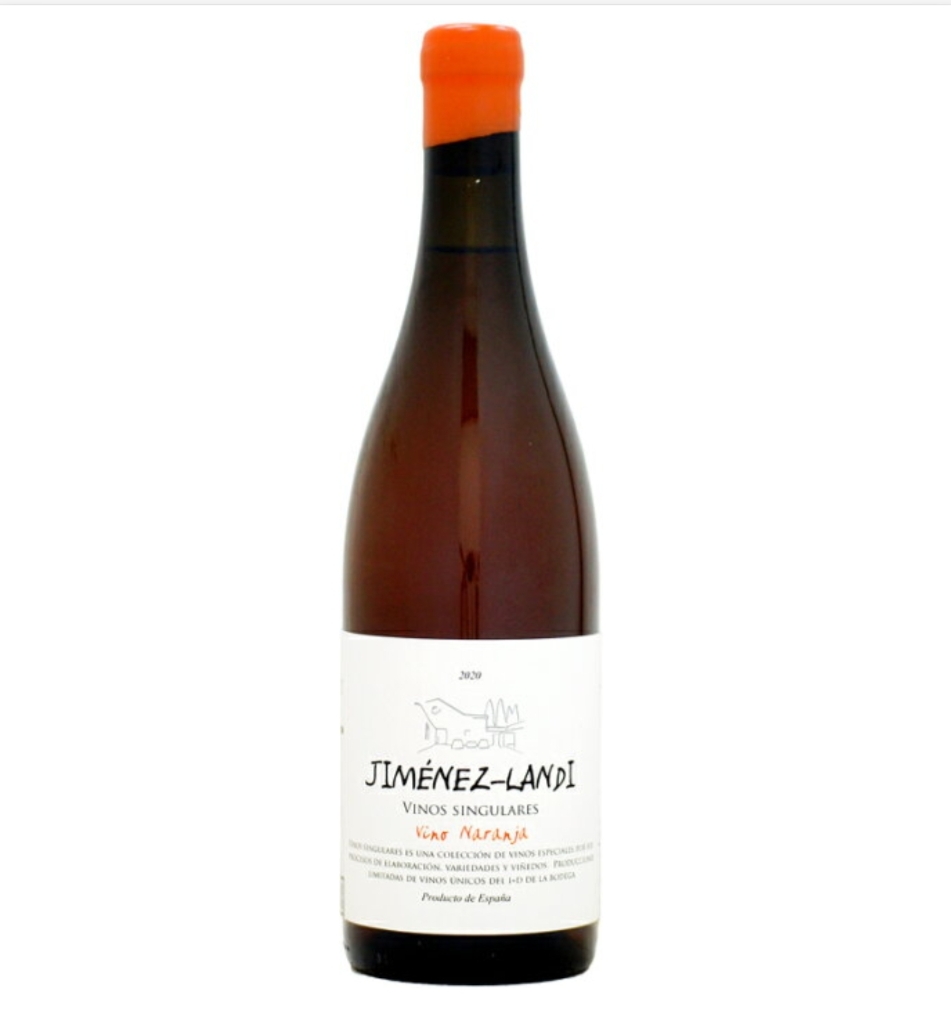
Quoting from the Mottox website:
This is an orange wine from a Madrid producer renowned for crafting elegant Garnacha with a Pinot Noir-like finesse.
While Garnacha is often associated with bold, robust wines, the high-altitude cultivation in the Sierra de Gredos region allows the wine to retain acidity and achieve an elegant finish.
Interestingly, this region originally produced inexpensive local wines, but as the trend shifted towards high-end wine, these vineyards were abandoned. Younger generations have since revived these forgotten vineyards.
Some vines are over 100 years old, resulting in lower yields but producing exceptional quality grapes. The winery has garnered high praise for its work.
Tasting Notes
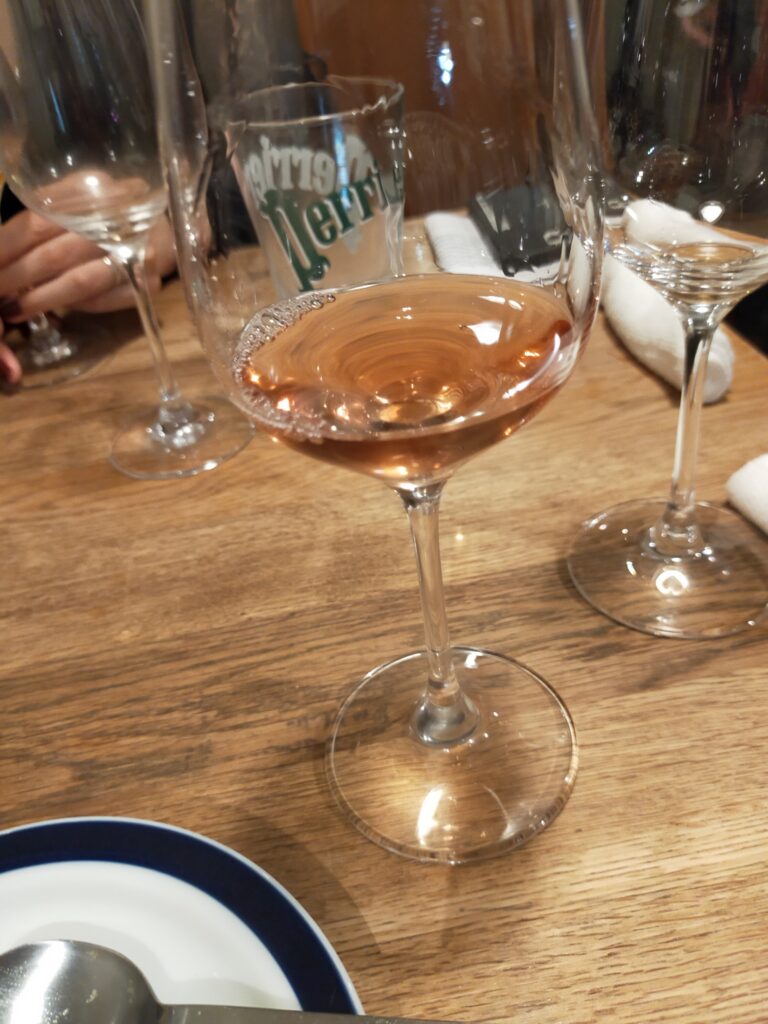
This orange wine is made from Garnacha Blanca and Malvar, two indigenous varieties.
It showcased a stunning pink hue—perhaps a bit confusing for an “orange wine,” so apologies for that!
Unlike some natural orange wines with less-than-pleasant aromas, this one was impeccably clean.
It had a lovely fragrance reminiscent of quince-flavored throat lozenges, with a hint of ginger-like spiciness—a truly delightful wine.
In Conclusion
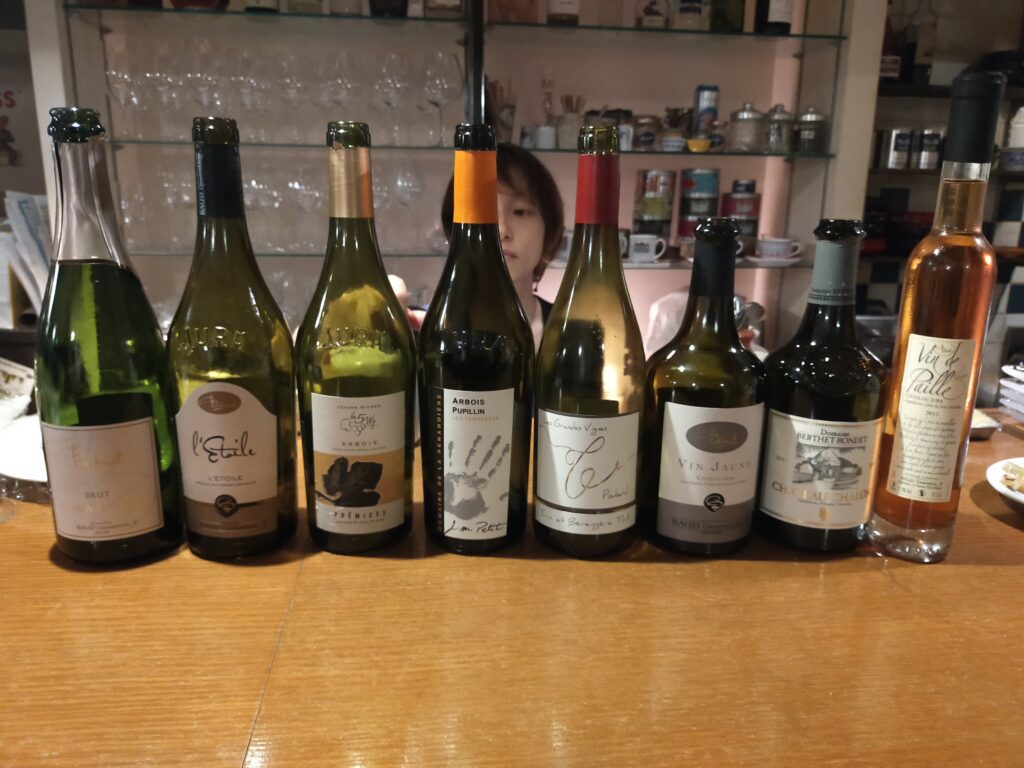
How did you find the world of Jura wines?
For me, it was an incredibly satisfying experience. These were wines I wouldn’t have chosen myself, and while I’d heard their names before, I’d never had the chance to taste them.
From the Whisky Messe to bar-hopping in Kyoto, and now this Jura Wine Gathering—thank you so much, Ai-san and Haruka-san, for accompanying me on these adventures.
Thanks to Eiji-san’s seating arrangements, I spent three hours in what felt like a dreamlike harem, grinning ear to ear the entire time.
On the way back, I intended to take the train to Saidaiji with Ai-san and Haruka-san, but I ended up boarding the train going in the opposite direction—classic clumsy me.
Thankfully, these two kind souls laughed it off and forgave me (or so I hope—if you were upset, I’m truly sorry).
The next NARA Wine Gathering will be a potluck-style event where participants bring their own wines to share.
I can’t wait to see what surprises await us.
I hope you’re looking forward to it too.
Until next time!
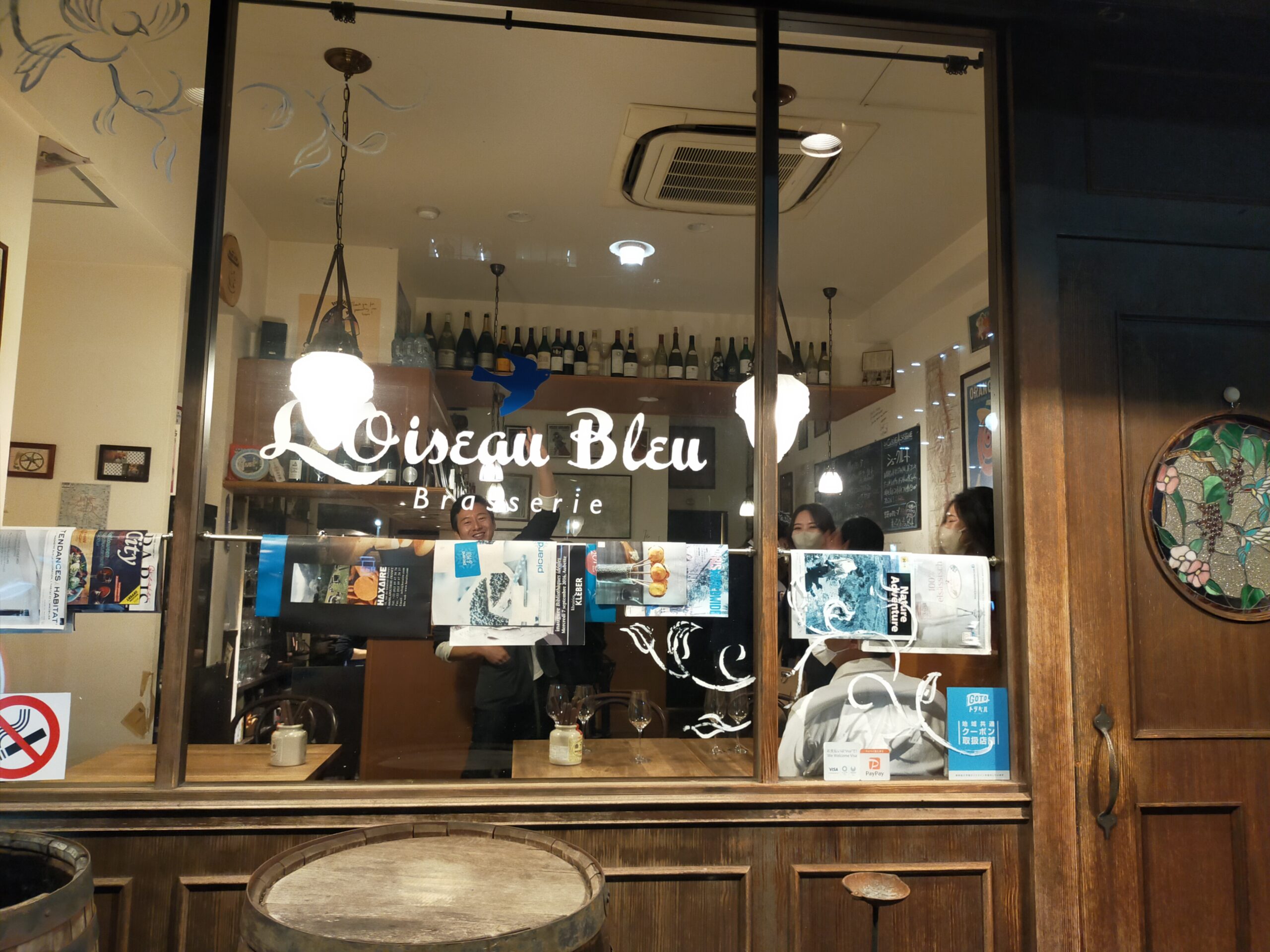




コメント